| WAT CHAI WATTHANARAM (วัดไชยวัฒนาราม) |
| And at the house of the Supreme Holy Imperial Mother, the Holy-Lord- Omnipotent ordered the construction of a holy great cedi reliquary. It possessed holy porticos surrounding it and the corners of those holy porticos were intervals. Arid it contained a holy recitation hall, a holy preaching hall, and a Buddhist academy, and dormitories were built and presented to the holy monks in great numbers. When it was finished it was given the name of the Monastery of the Victorious and Prosperous Temple. On its lord abbot the King bestowed the holy name of the Holy Victorious Senior Monk, Royal Abbot of the Forest Dwelling Sect, and on the monastery bestowed a steady consignment of food in perpetuity without cease in holy memory of His mother. [1] Location Wat Chai Watthanaram or the Monastery of the Temple for the Advancement of Victory as Richard Cushman translate it, is a restored ruin situated off the city island in the western area in Ban Pom sub-district. The large monastery is located on the west bank of the present Chao Phraya River in front of the Siriyalai Palace, which is situated directly across the river. The primary access to Wat Chai Watthanaram was from the river, as the waterways were the most important means of transport in that era. The Late Ayutthaya period begins in 1629 with the reign of King Prasat Thong and is most notable for the square-shaped or indented corners pagodas and for the re- emerging of the prang as the principal monument of the monastery. Khmer culture was revived with the building of Wat Chai Watthanaram. [2] Hiram Woodward wrote in his work Art and Architecture that It seems that the last prang built before Wat Chai Watthanaram was Ratchaburana, 1424. There is though quite some reason to believe that the building of Wat Worachet and its prang, was finalized long time before Wat Chai Watthanaram was inaugurated. We must although no take the sentence out of its context as Woodward wanted probably to point out that the architecture during Prasat Thong’s reign was strongly influenced by Khmer architecture and as thus more closely identified with the Early Ayutthaya period. [3] Many text and books tend to describe the architecture of Wat Chai Watthanaram as being similar to Angkor Wat. Although a magnificent monument, for those who have seen Angkor Wat, the view of Wat Chai Watthanaram will only be a far cry. History King Prasat Thong (r.1629-1656) built this royal monastery on the bank of the Chao Phraya River in 1630 in order to make merit for his foster-mother, as well to show himself as a man of great Buddhist merit; in fact a political goal [4]. The temple was built on the site where his foster-mother, the wife of Okya Sri Thammathirat, resided in Ayutthaya. [5] Wat Chai Watthanaram was one of the grandest and most monumental ruins of Ayutthaya. [6] The construction of the monastery may have taken 20 years to complete as a gold tablet buried behind a Buddha image in one of the spired roof halls was inscribed: Auspicious occasion in Maha Sakarat 572 (1649 AD), Wednesday of the 4th month, 15th day of the waxing moon, year of the dog with number two ending, firstly established. [7] In the Historical Account written by Van Vliet, in the passage referring to 1637-8, he mentions the King’s temple . . . under construction [8], indicating that at that time the construction work was still ongoing. Since the reign of King Prasat Thong all Ayutthayan Kings would regularly make pilgrimages to this sanctuary and attend royal funerals. In the last Burmese war with Ayutthaya (1764-1767), the site may have been used as a stronghold as witnessed by the reinforcement of the walls and the surviving remains of cannons and cannon balls. [2] After the destruction of Ayutthaya by the Burmese, the temple was deserted, prey for the jungle and looters for 220 years. Architecture Before we start with the architecture of the monastery it is interesting to hear what a traveller to Siam in 1655 has to say about his visit to this sanctuary. The large Abbentak is Wat Chai Watthanaram; the small Abbentak is Wat Phutthaisawan, on the French maps indicated as Pagode de la feue Reine. "Meanwhile we also viewed some of most elegant Siamese temples and pyramids, especially the large and the small Abbentak, one for the kings and the other for the queens, built in the grand manner at no little cost, glittering with gold and gemstones like a gilded mountain. The larger one has a wide and blunt domelike tower, elegantly sculpted and girded by gilded images. One could walk around it, and at the front side one could climb many stone steps to about half-way. There was a door that is not opened for anyone except, formerly, for the kings. Inside there are many images (said to be) made of solid gold. In front, at the entrance next to the stairway, there also stood many gilded statues in niches especially made for this purpose. And on every side an awe-inspiring, large man of stone guards the entrance, each with a tiger standing before him, a tiger which, it is said, he fought and vanquished. From there we walked under a broad and very long gallery that had been built around this tower in the shape of a large square, standing so completely full of large costly gilded images that we almost overlooked the extraordinary multitude of smaller medium-sized and very small images. It was impossible to count them. Many were of copper and metal. Most sat with legs crossed under the body as usual, though in every one of the corners and in other notable places some stood upright on their legs or feet. There were also so many middle-sized and very small ones, beaten from pure gold, that it seemed unbelievable." "Most of these figures were much bigger than men or women, as large as the greatest giants and giantesses about whom we might ever have heard or read. All the ones here were in beautiful proportions, modeled in brickwork and polished up with lime and then made smooth and even with black lacquer, on which they manage to attach very firmly the beaten gold, since I myself have seen how they made such images in a restored and hence 'new' temple not far from the lodge. To sum up, this certainly looked to be as beautiful and elegant a display as one is likely to find in all of papistry. This is especially true of the small Abbentak. As to size, construction, elegance, and multitude of images it matches the larger one. Moreover, these [images] all seemed newly gilded, all the way up to the highest vault. To simple folk this had the appearance of a small heaven. Even if I seem to write extensively about this, [what I describe here] is hardly half of what we ourselves beheld in astonishment." [9] Wat Chai Watthanaram is an example of symmetry. The temple is built on an east-west axis, oriented to the east; towards the main river and the upcoming sun. The monastery is nearly perfectly sculpted, rendering it a beauty as much in the horizontal as in the vertical plan. Most of the structures described here under still can be seen today, with exception of the vihara and the monk’s residences, which were likely mainly, built in wood. The use of eight spired roof halls or meru in the construction of the gallery makes Wat Chai Watthanaram a unique monument. The outer wall The temple complex of Wat Chai Watthanaram was surrounded by a rectangular wall measuring approximately 194 by 117 meters and having a height of about two meters. The foundations of this wall, which are still partly visible, have a width of approximately one meter. Originally the wall had eight arched gateways of about 2.5 meters high. The north and south sides had both two entries, on the west side there was one and on the river side three. Two gateways still can be seen today. These gateways had a triple tiered roof, arched like a barrel vault, and were decorated with parallel vertical ribs of stucco to imitate tiles. In Ayutthayan times there must have been a quite elaborate royal boat landing on the east side, as this was the main entry to the complex. From the landing a brick pathway led through the middle, eastern gateway into the sanctuary. [5] On the west side of the outer wall is only a single gateway. Foundations of what appeared to have been a road were found leading from this gateway. Apparently this road was a covered corridor, in order to screen off the ladies of the court at par of the “chanuan” found at the Grand Palace. On either side of this corridor were supposedly the monk’s quarters. The Chedi To the east close to the river stand two large identical chedi about 20 meters north and south of the ordination hall. The two chedi are the only original structures which were not situated on an elevated platform as thus. Both chedi, elevated on a square base, are typical of Prasat Thong’s reign being twelve- rabbeted-angled structures, with a single staircase on the east leading to the top of the base. The chedi with three rabbets on each angle (Th: chedi yo mum mai sip song), was developed from the redented added-angled chedi invented in the middle of the second sub-period. The twelve-rabbeted-angled chedi was kind of a “trademark” during the reign of King Prasat Thong. [10] What or whose ashes have been buried inside the chedi is not known. It could have been his mother’s and his father’s remains, especially as the monastery had been built in merit for his mother. It would be rather exceptional if these chedi would have been only built merely as decoration. The inner wall and main platform The brick pathway passed also the inner wall and led to the central staircase of the first of three raised platforms, about 1.5 meters high. The platform, which houses the ordination hall, the gallery and quincunx, is double redented on its corners. The inner wall which contained all the monastic structures, and which foundations were restored, had a height of 2.5 meters and surpassed the first platform, one meter. Next to the central staircase, there was also a staircase on the north and south side of the platform. [2] The Ordination Hall Climbing the central stairs you arrived on the main platform, straight in view of the restored ruin of the ordination hall (Th: ubosot). At present, only the elevated base remains. The rectangular structure measures about 45 meters in length and 19 meters in width. The ubosot was accessed by two small staircases to the east and west of the hall. The hall was built in what we call now the Middle Ayutthaya Period style, which implicates that the structure was completely surrounded by a porch. The porches on the east and west were about 4 meters deep; while on its length the porches were only over one meter wide. The three-tiered roof covered with glazed tiles, was supported by two colonnades of each five columns dividing the space in a central part and two aisles. The walls were made of brick and stucco, the most common used materials for temple construction at that time. The locations of the eight bai sema were reconstructed on their original positions. Different from Wat Maha That and Wat Racha Burana built in the Early Ayutthaya Period, is that here the ubosot is not penetrating the gallery at par with Wat Phutthai Sawan. Same as the vihara and ubosot of Wat Maha That, the side walls were divided into bays decorated with false windows, identical as the exterior of the gallery and the meru. The gallery The base of the gallery is about one meter above the main platform. The gallery surrounding the quincunx in the centre stands isolated from the ordination hall. Each side of the square gallery measures about 55 meters. The gallery can be accessed only through two doorways on the east and the west side. The walls of the gallery bear false windows, creating a decorative contrast of light and shadow within the gallery, a technique also applied to the royal vihara of Wat Maha That and likely copied from the temples at Angkor, but here executed in brick and stucco forming part of the walls. The inside wall of the gallery was painted with scenes of the Vessantara Jataka tale. The gallery was roofed and the roof supported by pillars running perpendicular with the walls. Holes in walls and columns are still witnesses of the wooden beams which formed the structure of the roof. Archeological excavations found evidence that the roofing material used were curved tiles with fascia decorations. The ridges were decorated with marble studs. [11] Within the gallery lining the inner walls were 104 gilt lacquered sitting Buddha statues in the attitude of “Victory over Mara”. Additional two images were flanking each meru, with their back towards the main prang; totalling another 16 Buddha statues. The gallery had eight "meru" or funeral pyres with a roof on each side, located in the four cardinal and four inter-cardinal directions. These eight 25-meter high spired roof halls look very similar as the "Golden Meru" used in the funerals of Royals, hence the use the word "meru". Each meru had an interior chamber, which open out on to the gallery and together contained a total of twelve large, seated and crowned Buddha images: two in each corner meru or “meru thit” and one in each midpoint meru or "meru rai". [12] The ceiling over the large Buddha statues was from wood with golden stars on black lacquered background. The roofs of the spired roof halls were in the shape of a prang with a Nophasun decorating the tops. [11] Beth Fouser uses the thai word "men" for "meru" and describes these funeral towers as follows: "They are square in plan with several redentations at the corners, making them roughly octagonal, and are about 25.5 metres in height, composed of seven tiers or storeys of diminishing size, almost like "the sections of a collapsible drinking cup"." A finial in the shape of a miniature prang originally surmounted the men, though only fragments of these have survived. There are openings from the gallery through each men, making circumambulation of the gallery possible. The corner men have two openings into the gallery only, whereas the midpoint men have three openings: two into the gallery and one into the courtyard, which then leads to the staircases of the central prang. Originally there were gabled roofs attached to all four sides of each men, making them symmetrical, but these have not survived. The square holes where wooden beams were attached to support the roofs, and on some of the men the original wooden beams themselves are visible. Enclosed by porches on the two outer sides of the corner men and the single outer side of the midpoint men are large stucco relief panels depicting scenes from the life of the Buddha. The outside walls of the porches are decorated with the same stepped mullion design that appears along the exterior gallery walls." [13] The exterior of the funeral towers was decorated with stucco relief panels, twelve in total, depicting scenes from the Jataka (Buddha’s life) clockwise. Some fragments of the paintings and the reliefs still can be seen (but not for long anymore). The Quincunx The gallery encloses an open courtyard. In the middle of this courtyard stands the quincunx; the main prang with four minor prangs situated at the four inter-cardinal directions, all standing on a raised square platform. Wat Chai Watthanaram was built as a Khmer Temple Mount, with the central prang representing Mount Meru. The main prang is 35 meters high and has a steep staircase on each cardinal side, leading from the courtyard to a large niche. Only the niche on the east led into an interior chamber. This prang is an example where the cella or antechamber of the Early Ayutthaya Period was replaced by a niche. Originally the interior chamber and the niches held Buddha images, but are now empty. [2]. The four minor prangs measure each about 11 meters in width and five square meters at the base. [14]. The stucco surface of the prangs bear nail-holes. It is believed that the holes were made by pins used to attach sheets of gold-plated tin to its surface, covering the five prangs in shimmering gold. [15] Other structures On the northern side of the main platform, next to the north wall of the gallery we find a small chedi. This chedi obviously was not part of the initial construction and was added at a later date. A small prang with antechamber is situated north of the inner wall, bear also traces from an architecture of a later date. It was also not part of the original design of the temple. [16] Chaofa Thammathibet Chaichet Siriyawong (Chaofa Kroma Khun Senaphithak) was the eldest son of King Borommakot (reign 1733-1758) and his first queen Kroma Luang Aphainuchit. He was commonly known as "Chaofa Kung" and was appointed heir apparent. He died from a series of punishment given by his father because he accessed the Royal chambers with false keys, visited at night four royal concubines and planned to seize power. He was cremated at Wat Chai Watthanaram and his remains were placed in a chedi as was custom for royals that time. He was a poet and the writer of many travel poems such as "Kap Ho Khlong Nirat Phra Bat", "Kap Ho Khlong Praphat Than Thongdaeng" and the "Kap He Ruea" boat songs. Also Chaofa Sangwan, the third queen of King Borommakot and granddaughter of King Petracha, as Chaofa Nim, the King’s first concubine, were cremated at Wat Chai Watthanaram. The foundations of these three chedi can still be seen on the northern side. [17] A report by a Sri Lankan envoy who visited Wat Chai Watthanaram in 1750 describes two additional buildings, one containing "various images of the Buddha and two figures of the Sacred Footprint with the auspicious symbols in gold," and the other, "a similar hall to the west with three Buddha images." Fouser presumed these structures were vihara. No traces remain however from these buildings and were probably added after Wat Chai Watthanaram was built, as the complex was conceived as a whole. [18] Symbolism Wat Chai Watthanaram reflects the Buddhist world view, as it's described already in the Traiphum cosmography. The universe consists of an infinite number of solarsystems (Chakrawan), each depending on a central mountain named Phra Men, or Meru. Around this central mountain are eight circular belts of ocean, divided from each other by seven annular mountains (Satta Boriphan). Outside of all is an eighth ring of mountains, called the Crystal Walls of the World. On the ocean between the seventh mountain-chain and the walls of the world, which is called the Great Ocean, are four groups of islands, each consisting of a principal island and 500 satellites. The group to the south, called Jambudvipa (Siamese, Chomphu Thawip), is that inhabited by man; the groups to the north, the east, and the west, are inhabited by beings akin to man, but differing in appearance. [19] The main prang represents as thus Mount Meru, the central axis of the world and the abode of the gods; the prang is surrounded by four smaller prangs at each corner on the same platform, representing the four continents; the courtyard represents the seven oceans and the gallery the seven annular mountains. The outer wall symbolizes the crystal mountain Chakrawan and as thus is called Kamphaeng Kaeo or crystal wall. Wat Chai Watthanaram on old maps Maps of Ayutthaya with an indication of Wat Chai Watthanaram were first published in 1724. The monastery complex is mentioned as the "King's Golden Pagoda" on the detailed map of the Chao Phraya River and beyond (De Groote Siamse Rievier Me- Nam), belonging to François Valentijn's work Oud en Nieuw Oost-Indien, 1724-1726. In 1751 Jacques Nicolas Bellin published in l'Abbé Prévost's "Histoire Générale des Voyages" a map of Ayutthaya named “Plan de la Ville de Siam, Capitale du Royaume de ce Nom; Levé par un Ingénieur François en 1687” on which Wat Chai Watthanaram is labelled as "Pagode Royale." Piriya Krairiksh suggests it may have been called Wat Pallankara Aramwihan, and have been renovated and enlarged between the 1730s and 1750s. [20] Excavation and restoration Primary excavations at this site were conducted after the excavations of Wat Phra Ram in 1958. Though the ancient structures had already been disturbed by the treasure hunters, many precious objects were unearthed in the crypt of the main prang. Only in 1987 did the Thai Department of Fine Arts start restoring the site. In 1992 it was opened to the public. The Thai government allocated 49 million Baht in April 2007 to save the historical river site from further erosion. The money was spent on reinforcing and strengthening the 20- year-old concrete dyke to prevent the Chao Phraya River from eroding the sanctuary. The renovation work was jointly undertaken by the Fine Arts Department and the Public Works and Town and Country Planning Department. [21] |


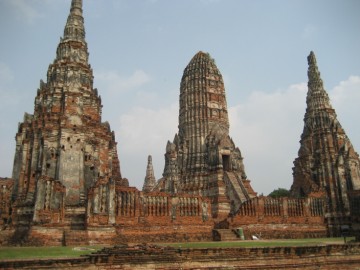

| References: [1] The Royal Chronicles of Ayutthaya - Richard D. Cushman (2006) - page 215 / Source: Phan Canthanumat, British Museum, Reverend Phonnarat, Phra Cakkraphatdiphong & Royal Autograph. [2] Ayutthaya: World Heritage Reflections of the Past - Ayutthaya Provincial Administration Organization - page 48. [3] Art and Architecture - Hiram Woodward (2005) - page 64. [4] Van Vliet's Siam - Chris Baker, Dhiravat Na Pombejra, Alfons Van Der Kraan & David K. Wyatt (2005) - page 20. [5] The Lord of the Golden Tower - Beth Louise Fouser (1996) - page 44. [6] Van Vliet's Siam - Chris Baker, Dhiravat Na Pombejra, Alfons Van Der Kraan & David K. Wyatt (2005) - page 20. [7] Ayutthaya: World Heritage Reflections of the Past - Ayutthaya Provincial Administration Organization - page 50. [8] Van Vliet's Siam - Chris Baker, Dhiravat Na Pombejra, Alfons Van Der Kraan & David K. Wyatt (2005) - page 138. [9] A Traveler in Siam in the Year 1655: Extracts from the Journal of Gijsbert Heeck - Barend Jan Terwiel (2008) - page 61, 62. [10] An Outline of the History of Religious Architecture in Thailand - Sonthiwan Intralib (3th Ed - 1991). [11] Ayutthaya: World Heritage Reflections of the Past - Ayutthaya Provincial Administration Organization - page 52. [12] The Lord of the Golden Tower - Beth Louise Fouser (1996) - page 53. [13] Ibid. page 57-59. [14] Ibid. page 89, 125. [15] Ibid. page 90. [16] Ibid page 53. [17] Dutch East India Company Merchants at the Court of Ayutthaya: Dutch Perceptions of the Thai Kingdom, 1604-1765 - Bhawan Ruangsilp (2007) - page 201-202. [18] An account of King Kirti Sri's embassy to Siam in Saka, 1672 (1750 A.D.) - Paulus Edward Pieris - "Siam Observer" Office, 1908 - page 20. [19] The Weel of The Law - Henry Alabaster (1871) - Trubner & Co, London - page 12,13. [20] Van Vliet's Siam - Chris Baker, Dhiravat Na Pombejra, Alfons Van Der Kraan & David K. Wyatt (2005) - page 46. [21] NNT - Department of Fine Arts receive 49 million baht funding from Cabinet - 02 April 2007. |
| Text, ground plan, interactive map & photographs by Tricky Vandenberg 28 September 2010 |


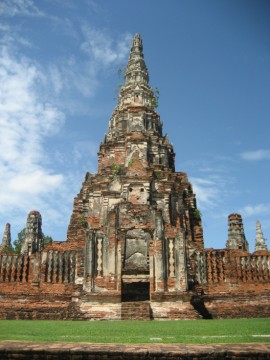


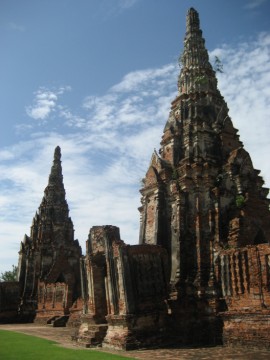




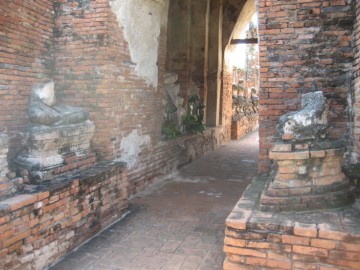
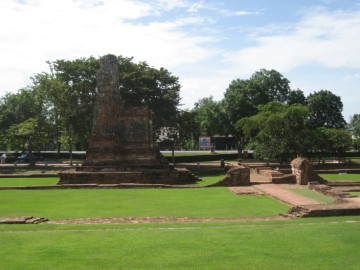
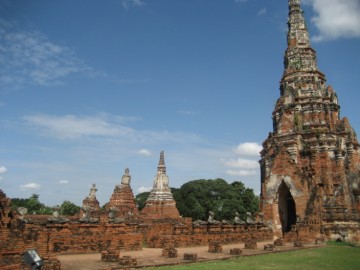
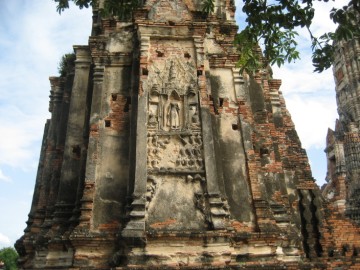
| (View from the west and the chanuan) |
| (View from the north-west) |
| (View of the ubosot) |
| (Northern chedi) |
| (False windows) |
| (The gallery) |
| (Stucco relief panel on meru) |
| (One of the eight Meru or spired roof halls) |
| (Meru in line) |
| (Main prang of the quincunx) |
| (Small prang, later added to the sanctuary) |
| (Small prang, view from the south) |
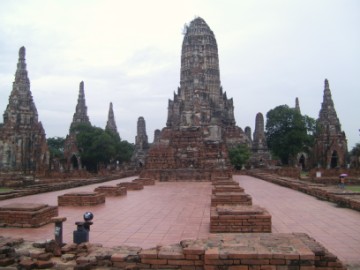
| (View from the ubosot in the east) |

| (Crowned Buddha within the meru) |


| (View from the west) |
| (View from the west) |
| (View of the meru and central prang) |
| (View of a meru from the north) |
| (View from the north) |